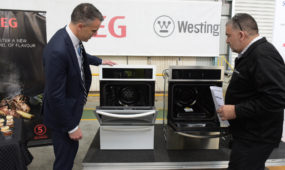Bluetooth mining sensors save time and money in diamond drilling
Manufacturing
BLUETOOTH technology is being used to increase the efficiency and precision of diamond drilling.

Sign up to receive notifications about new stories in this category.
Thank you for subscribing to story notifications.
The Wireless Sub was developed by Deep Exploration Technologies Co-operative Research Centre (DET CRC) in South Australia and uses Bluetooth sensors to deliver precise drill rig data.
The sub couples the drill rig to the drill rods in the hole and enables drillers to replicate the highest performing parameters in any drilling program.
The steel component can be retrofitted to any drill rig and measures feed force, torque, water pressure, rotation speed, axial force, tangential acceleration as well as drill bit erosion.
The Wireless Sub was developed in collaboration with CSIRO, Globaltech Corporation, Epslog and will now be commercialised by mining technology group Boart Longyear after it signed an agreement with DET CRC last week.
DET CRC Chief Executive Officer Richard Hillis said the sub not only optimises drill performance but also measures properties that have not been monitored in similar technologies.
“Existing measurements are made based on pressures in the hydraulic fluid rather than the actual stresses and strains on the drill string,” he said.
“One of its key features is it measures drill bit life, which can save the driller a lot of time because it allows them to avoid having to change the bit so often.”
Hillis said the sensor was designed for diamond drilling but had the potential to be used in other areas as well.
The sensors collect the drill rig data and send the information through to a nearby laptop.
A dashboard then illustrates rates and pressures, giving drillers the ability to change rotation speeds, insert additional fluid and alter the weight on the bit as soon as necessary.
The real-time data from the remote drilling sites can also be reviewed by exploration teams around the world and can be used by drillers of any experience level.
The Wireless Sub was trialled and tested at the Gawler Craton in central South Australia, which covers about 440,000 square kilometres of mineral rich terrain.
It was set the task of drilling a piece of ground adjacent to a contemporary system with conventional gauges.
The results showed the hole dug by the rig with the Wireless Sub had a 10 per cent increase in rate of penetration. It also increased drill bit life by more than 100 per cent.
Boart Longyear Director of Geological Data Services Mike Ravella said he was pleased to add the Wireless Sub to the company’s suit of innovative technology.
“The information obtained from the detailed parameters recorded by the Wireless Sub is the next step in driving safe drilling productivity,” he said.
“In addition, there is much more that can be done with the data.”
The Wireless Sub is the third major technology licensed by DET CRC, following the AutoSonde for downhole determination of rock properties and the Lab-at-Rig for surface determination of geochemistry and mineralogy.
Together these technologies provide a suite of real-time or near real-time drilling, geophysical and geological data from the drill site.
DET CRC was established in 2010 under the Australian Government’s Co-operative Research Centre Program to develop technologies to discover new mineral deposits at depth beneath barren rock cover.
Jump to next article



